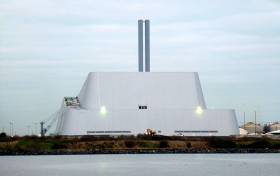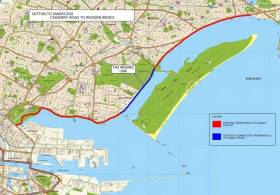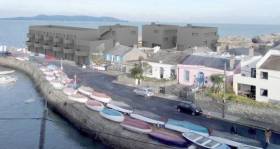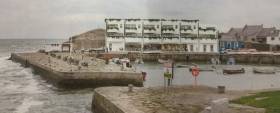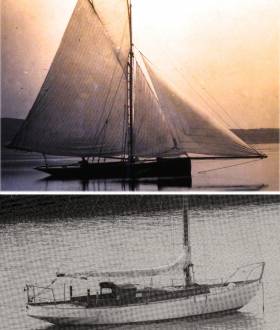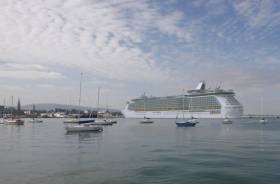Displaying items by tag: Dublin Bay
Dublin Bay Incinerator: The Pyramid of Poolbeg or Ziggurat Of Zandymount? You Tell Us...
Those of us who only occasionally head down the Sandymount seafront along the inner reaches of Dublin Bay will be driving carelessly if we give the attention it deserves to the impressive new structure which is taking shape on the Poolbeg Peninsula writes W M Nixon.
You’ve got to stop and get out and give it a proper look from as many angles as possible, for whatever it is, it’s quite something. And it doesn’t seem hostile. Yet so impressive is it that you could be forgiven for thinking that all the talk about building a giant film studio in the area has been simply a blind – the reality is that Hollywood-On-The-Bay is already nearing completion, and the first production will be Brexit – The Movie, starring Donald Trump’s friend Meryl Streep as Theresa May.
Not a bit of it, alas. We’ve been well aware from the other side of the river while sailing at Clontarf that the new Covanta Incinerator has been rapidly under construction. But it’s only when you see it from the south in recent days, in this extraordinary calm still silver grey light that denies we’re in the dark depths of January, that you realise it really is something quite remarkable.
 The new IDRA 14 Wicked Sadie racing at the class’s 70th Anniversary regatta at Clontarf last September. Construction of the incinerator (beyond) was already under way, but its full impact is lessened when seen from the north. Photo: W M Nixon
The new IDRA 14 Wicked Sadie racing at the class’s 70th Anniversary regatta at Clontarf last September. Construction of the incinerator (beyond) was already under way, but its full impact is lessened when seen from the north. Photo: W M Nixon
Whatever your views about an incinerator on the waterfront of a city (and don’t forget that the very beau ideal of a city, Copenhagen no less, has its own incinerator, and is none the worse for it) the reality is that this is an awesome structure in its own right, and I cheerfully admit to liking the look of it very much indeed.
It’s all of a piece. It makes some of the other industrial structures about it look very scruffy. And we’ll certainly have to get the old ESB twin smokestacks re-painted pronto. As for the Dubs, they’re going to have a fine old time giving it a nickname, if they haven’t done so already.
The Ziggurat of Sandymount (we’ll have to change it to Zandymount), or the Pyramid of Poolbeg spring readily to mind. Maybe the Apex of Ash might be a contender too. Whatever it gets called, there’s no escaping the fact that it’s here to stay.
Then after we’ve all been blown away in the inevitable nuclear holocaust which the present re-ordering of the world makes very likely, can’t you just imagine the archaeologists of 5,000 years hence earnestly analyzing it and proving beyond all doubt that it was a sacred temple for the worship of money, with its main corridor exactly in alignment with the point on the horizon beyond which the sun rises on the Frankfurt Stock Exchange on Midwinter’s Day?
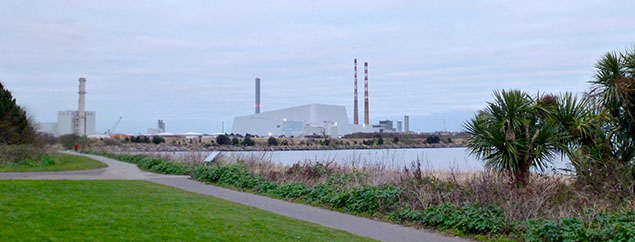 The new Zandymount Ziggurat makes the other industrial structures in its neighbourhood look a bit scruffy. Photo: W M Nixon
The new Zandymount Ziggurat makes the other industrial structures in its neighbourhood look a bit scruffy. Photo: W M Nixon
Clontarf Section Of Dublin Bay Cycleway To Open March
#S2S - The latest section of the Sutton to Sandycove (S2S) cycle route around Dublin Bay will not be opened till March due to delays on water main works, as Irish Cycle reports.
Once completed, the new cycle track — with mixed pedestrian and cyclist sections at junctions — will connect the pre-existing tracks between Sutton and the Bull Island causeway, and the route from Bull Bridge to East Wall Road.
As yet no section of the southside portion of the S2S has been completed, though a public consultation on the corridor from Sandymount/Merrion to Blackrock is currently open for public consultation till 31 January.
Irish Cycle has more on the story HERE.
Residents To Fight ‘Costa del Sol’ Style Development in Dalkey
#BullochHarbour - A major campaign in Dalkey is under way to stop what has been described as the ‘Costa del Sol’ style development at Bulloch Harbour in south Dublin.
As The Irish Times writes on the eve of its 200th anniversary, the coastal inlet has been selected by developers as previously reported on Afloat for a commercial and residential scheme that would visually transform a postcard quay popular with fishermen and tourists.
The controversial plans have drawn the ire of local residents, more than 300 of whom crammed into a public meeting at the Fitzpatrick Castle Hotel in Killiney on Thursday to discuss mass opposition.
A 50-minute presentation described a harbour that has existed for hundreds of years and whose modern walls were constructed over just eight months in 1818.
In December, Bartra Capital Ltd, founded by developer Richard Barrett, filed a planning application that would see the replacement of a number of disused sheds with seven ground floor commercial units and six three-storey terraced dwellings,plus a further three houses to the rear.
“This development could be taken from the Costa del Sol. It’s not Irish seaside architecture,” said Susan McDonnell, chair of the Bulloch Harbour Preservation Association (BHPA), outlining the contentious plans.
Those in attendance groaned at a crude computer mock-up depicting dark buildings towering over the existing colourful harbour scene.
For more including slide images of a before and after of the projected development (3-D graphic above) at Dalkey click here.
Campaigners Public Meeting To Discuss Proposed Development at Dalkey’s Bulloch Harbour
#BullochHarbour - Concerned residents and marine users of Bulloch Harbour, Dalkey, Co. Dublin are to hold a public meeting tomorrow (Thurs. Jan.5th) over a proposed mixed development at a sensitive coastal site of the former premises of Western Marine, writes Jehan Ashmore.
Afloat last reported just before Christmas of the proposed development by Bartra Property that acquired the site of the chandlery business that are to relocate locally. The site is fronting the quayside of the scenic Dublin Bay harbour. It is one of the last working harbours in the bay with fishing boats, is popular for marine leisure activities and as a tourist attraction in the salubrious southside suburb.
Last month the developer lodged a planning application to seek permission to demolish the single-storey warehouse (1,210 sq m) and replace with the construction of several structures totalling (2,324 sq m) and each of these buildings of three-storeys in height. Click for previous report / image here. According to Save Bulloch Harbour facebook page a public meeting is to be held tomorrow to discuss the development at the Fitzpatrick Hotel, Killiney, Thursday at 7.30pm.
The meeting organisers, Bulloch Harbour Preservation Association whose members include boat users, Dalkey Sea Scouts, Dalkey Community Council and Tidy Towns have raised strong concerns on the proposed redevelopment. The Association claims the proposed development given on grounds of scale, height and bulk will adversely impact and destroy the unique heritage character of the historic harbour that has its origins dating to the 12th century.
Part of the proposed development is a block comprising of two and three stories high containing seven commercial units for marine businesses at ground floor level along the quayside. One of the marine units would be set aside for a café. In addition to six residential apartment units (each of around 1,660 sq ft) at ground floor to the rear and first and second floor overhead. The design of the apartments would feature balconies and roof gardens overlooking the harbour.
In addition at the rear of the former marine chandlery boat storage yard are proposed three houses (each up to 4,800 sq ft). Likewsise of the mixed development block, these dwellings are three-storeys high along with roof terraces. These residential units would exceed the height of the mixed block fronting the harbour built of Dalkey granite. Such cargoes from local quarries were shipped across the bay to assist the Ballast Board in the construction of Dublin Port during the 19th century.
In planning permission documents lodged by Bartra Property to the planning office of Dun Laoghaire-Rathdown County Council, the developers cite in their Planners Report that the brownfield site at Bulloch Harbour, is under the county development Plan 2016-2022. The lands at Bulluch Harbour are zoned with Objective W ‘to provide for waterfront development and harbour related uses’. The developer claims the café along the waterfront will enhance the amenity of the quayside.
New Boats for Ireland For The New Year? There Are Other Ways to Change...
The traditional timing of the London International Boat Show as soon as possible after New Year’s Day may have been shifted about in recent years as the changing dynamics of the European marine industry and the sheer dominance through size of Dusselboot (this year’s is 21st to 29th January) have changed the map of international boat selling. Nevertheless the idea that the very beginning of the New Year is an ideal time to interest people in a new boat still holds good, as they’ll invariably be convinced they’ve thought only of gifts for others over Christmas, while their entire lives have been taken over by family festivities. So when New Year arrives, a personal treat with a change in boats is well earned. But is it necessary to get a completely new boat? W M Nixon points to a different solution.
The most significant fact to emerge from the final results of this week’s Rolex Sydney-Hobart Race is that no new boat figured in the top five places overall. All were boats of varying vintage, some quite old relatively speaking. And all had been - at the very least - tinkered around with more than somewhat, even if none had been modified so frequently and completely as the Oatley family’s hundred footer Wild Oats XI.
Admittedly Wild Oats didn’t even finish, but she was leading on the water well past the halfway stage when she had to pull out with a failed keel ram. It could well be that this was one of the few original items in the boat, for Oats has been radically changed so often - with new longer bows fitted at frequent intervals with the stern shortened still further to keep her under a hundred feet – that she now looks for all the world like a one-masted schooner.
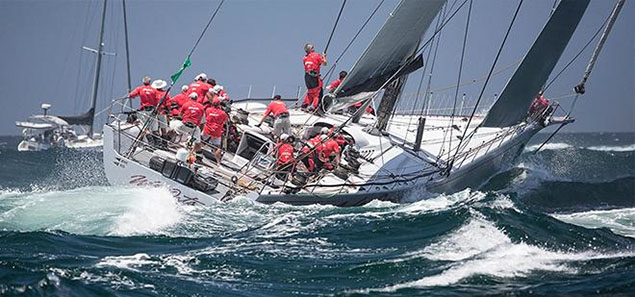 Wild Oats XI has had so much added to her length forward and so much chopped off her stern that she now looks like a one-masted schooner
Wild Oats XI has had so much added to her length forward and so much chopped off her stern that she now looks like a one-masted schooner
Yet at no stage have any of her skillfully-executed hull mods failed. Down in Australia, and in New Zealand too, they’re past masters at doing incredible things with epoxy which, once the job has been finished, look as if they’ve been there from the start. And the fact is that when we look back on the history of sailing development, when timber construction was dominant, the more individualistic shipwrights were game to take on all sorts of challenges for they knew – or at least most of them new – just what could be done with wood while retaining the overall sea-going integrity of the much-changed vessel.
It was only when fibreglass took over as the dominant boat construction material in the 1960s that we went through a period of nervousness of configurational change, when what you got in a plastic boat stayed as what you got in that plastic boat. For a while, people were scared stiff of making any changes to what had emerged from the mould and subsequently from the finishing shop.
But if your boat happened to be of wood, or better still of aluminium or steel, you could emulate the modifiers of old and introduce changes which managed to be locally strong, and also strong within the overall structure of the boat.
Once upon a time, back in 1974, we found ourselves berthed in Crosshaven outside Eric Tabarly’s 64ft ketch Pen Duick VI after an RORC race from Cowes, which he had won both on the water and on IOR. Despite this, the great man was dissatisfied with the location of the sheet leads for the Yankee jib (he had an Illingworth-style cutter rig). So he and his lads got hold of a generator, and there before our very eyes they set up an aluminum welding workshop, cut off the eye, and re-located the sheet leads to the skipper’s satisfaction.
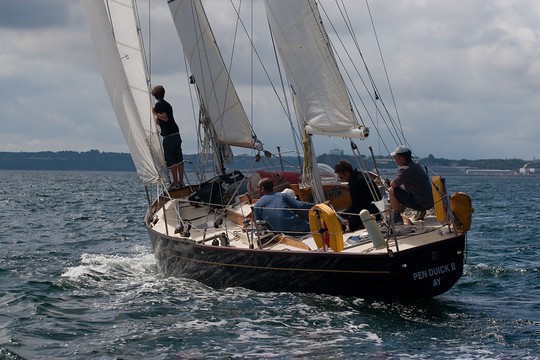 Only the coachroof coaming was timber - Eric Tabarly’s alloy ketch Pen Duick III was easily modified if you’d the aluminium welding kit.
Only the coachroof coaming was timber - Eric Tabarly’s alloy ketch Pen Duick III was easily modified if you’d the aluminium welding kit.
For sure there was singed paint in every direction, but the job was done, and Pen Duick won the next RORC race to somewhere in Brittany even more convincingly, while we sailed home to Howth reflecting that maybe there was more to aluminium than a rather soul-less material best used for building aircraft.
But of course we didn’t need to look very far to see boats that had been modified, sometimes beyond all recognition, in order to maintain appeal to a new generation of sailors. While the Howth 17s of 1898 may have stuck stubbornly to their original design – which they still do – the Dublin Bay 21s of 1902 had since 1963 been changed to Bermudan rig with a new coachroof.
 Dublin Bay 21 in original form – they kept their crews busy, and offered scant comfort or shelter. Photo: Rex Roberts
Dublin Bay 21 in original form – they kept their crews busy, and offered scant comfort or shelter. Photo: Rex Roberts
 The Dublin Bay 21s as they were from 1963 until 1986 - more easily handled, and the luxury of a doghouse,
The Dublin Bay 21s as they were from 1963 until 1986 - more easily handled, and the luxury of a doghouse,
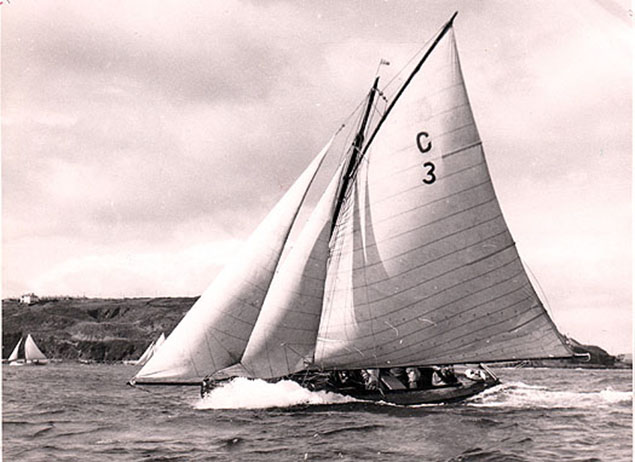 Cork Harbour One Design with classic rig, and open cockpit. Photo: Tom Barker
Cork Harbour One Design with classic rig, and open cockpit. Photo: Tom Barker
 Cork Harbour One Design in bermudan-rigged cruising mode, complete with coachroof and doghouse. Photo: W M Nixon
Cork Harbour One Design in bermudan-rigged cruising mode, complete with coachroof and doghouse. Photo: W M Nixon
And in Cork Harbour, the more senior Cork Harbour One Designs of 1896 vintage had become able little Bermudan-rigged cruisers with an extensive coachroof – complete with doghouse – which allowed them to log some very impressive cruises.
But in both cases, while the boats may have looked completely different above the deck line, their basic hull shape remained the same. Yet if you cared to look in the Coal Harbour in Dun Laoghaire, until the early years of this century a regular resident was the 32ft Bermudan sloop Bonito, which had started life as a plumb-bowed gaff cutter built in Strangford in 1884, yet by the time she reached Dun Laoghaire she was spoon-bowed and sloop rigged under the Bermudan configuration, her owner-skipper being Roy Starkey, whose regular crewmate was Bob Geldof Senr.
In fact, re-configuration seems have been a fact of life for Bonito during much of her existence, as at one stage she was yawl rigged too. But the fascination abut her lay in discerning where the constructional changes had been made to transform her appearance, and it’s a matter of regret that when her life came ignominiously to an end some time after Roy’s death, with the powers-that-be breaking up Bonito and consigning her to a landfill, it was over and done with before anyone was sufficiently aware of what was happening to ensure that her breaking-up a forensic dissection rather than a crude scrapping.
Of particular interest would have been the way in which her straight stem was lengthened into the spoon bow which became fashionable in the 1890s, and has remained fashionable with foredeck crews ever since, as it means you can work at the stemhead without being immersed in every wave, whereas straight stems – or worse still, the reverse stem as seen on CQS in the Hobart race – are a semi-permanent waterfall.
Yacht design undergoes strange mutations which can persist in exaggerated form, and one of the worst was the heavily-canted rudder which began to emerge in the 1840s when the main measurement for handicap and other purposes was along the length of the lower side of keel. The boat builder and designer Thomas Wanhill of Poole in the south of England was soon turning out boats which were significantly larger than their keel length – and hence their rating measurement – suggested, simply by increasing the angle of the rudder.
 John Mulholland’s 1865-built Egeria
John Mulholland’s 1865-built Egeria
So even though the sweetly-steering schooner America with her vertical rudder came across the Atlantic in 1851 and swept all before her, in England the trend towards angled rudders persisted, and in 1865 Wanhill built his most successful schooner, “the wonderful Egeria”, a 99-footer for linen magnate John Mulholland of Belfast, and she performed like a dream despite her markedly angled rudder.
Having the angle enabled the rudder head and the tiller to be well aft to keep the deck amidships clear for crew work, but somehow the idea persisted and indeed became exaggerated until the 1960s, with the Sparkman & Stephens-designed Clarion of Wight, overall winner of the 1963 Fastnet Race, having a rudder which today looks absurd. Admittedly she was a dream to windward, but offwind and particularly with spinnaker set, she was a nightmare on the helm.
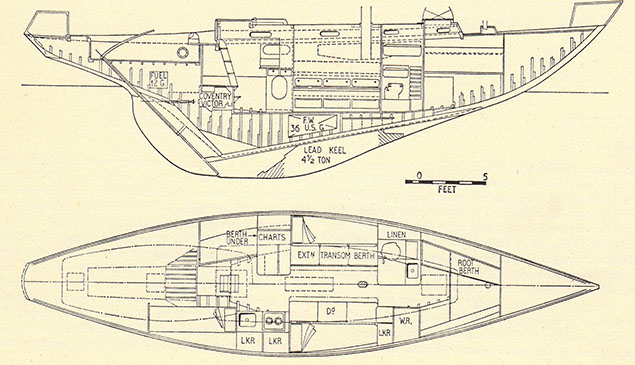 She may have won the 1963 Fastnet Race, but in her original form Clarion of Wight had carried the angled rudder to absurd levels.
She may have won the 1963 Fastnet Race, but in her original form Clarion of Wight had carried the angled rudder to absurd levels.
 Clarion’s successor Firebrand in 1965 showed some modifications to the old rudder shape, but Dick Carter’s new find-and-skeg configured Rabbit won that year’s Fastnet.This particular line of development was knocked in the head when Dick Carter won the Fastnet Race overall in 1965 with his own-designed Rabbit, which was fin-and-skeg with a virtually vertical rudder, and was well-behaved on all angles of sailing. But at the time most sailors persisted in what they thought were improved versions of the old form, and in ’65 Dennis Miller, one of the part-owners of Clarion in ’63, appeared with the new similarly-sized Firebrand with a less steeply-angled rudder which had a pointed tail to give extra power at maximum depth, and that did improve things slightly. But nevertheless Firebrand continued to be the most beautiful-looking boat with the drawback of challenging helming under spinnaker, though as we’ll see, that was to be sorted in due course.
Clarion’s successor Firebrand in 1965 showed some modifications to the old rudder shape, but Dick Carter’s new find-and-skeg configured Rabbit won that year’s Fastnet.This particular line of development was knocked in the head when Dick Carter won the Fastnet Race overall in 1965 with his own-designed Rabbit, which was fin-and-skeg with a virtually vertical rudder, and was well-behaved on all angles of sailing. But at the time most sailors persisted in what they thought were improved versions of the old form, and in ’65 Dennis Miller, one of the part-owners of Clarion in ’63, appeared with the new similarly-sized Firebrand with a less steeply-angled rudder which had a pointed tail to give extra power at maximum depth, and that did improve things slightly. But nevertheless Firebrand continued to be the most beautiful-looking boat with the drawback of challenging helming under spinnaker, though as we’ll see, that was to be sorted in due course.
Meanwhile Clarion of Wight continued to be a handful, so before the 1960s were out, builder Clare Lallow of Cowes was asked to perform the then-major operation of transforming her after-body underwater to give her a fin-and-skeg configuration master-minded by Sparkman & Stephens, who were now advocating this shape with all the zeal of the convert, and in fact had used early versions of it in boats like Deb, later Dai Mouse III, now Sunstone, which had been built in 1965.
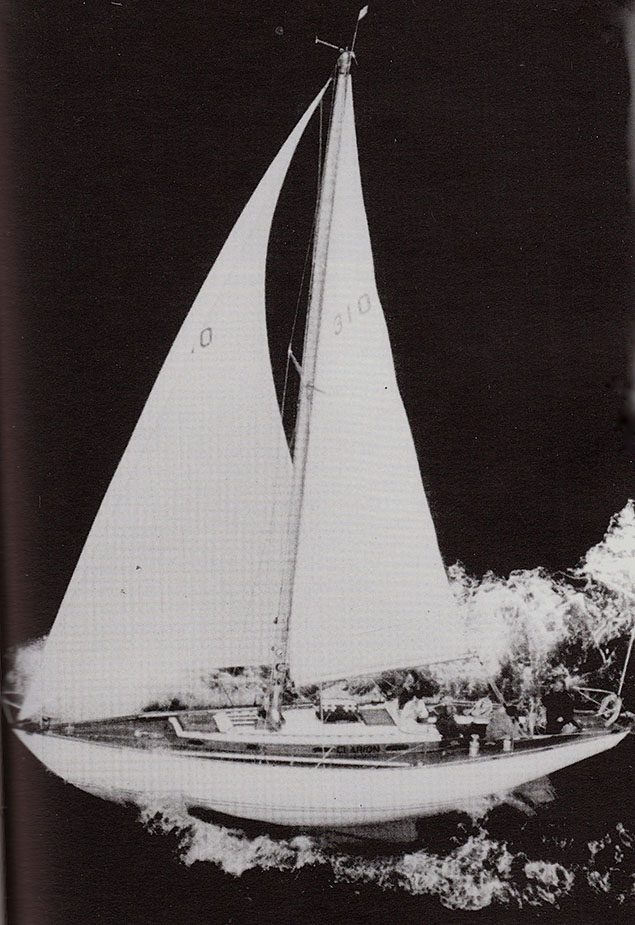 Clarion of Wight in the 1971 Fastnet Race in Rory O’Hanlon’s ownership, when she won the Philip Whitehead Cup. Her new vertical rudder arrangement is discernible.
Clarion of Wight in the 1971 Fastnet Race in Rory O’Hanlon’s ownership, when she won the Philip Whitehead Cup. Her new vertical rudder arrangement is discernible.
Thus to some extent it was the conservatism of owners which persisted in keeping the old style, and of course the vertical separate rudder had long since been advocated by designers like Ricus van de Stadt and Uffa Fox. However, getting the change to into favour with the mainstream in sailing was a different proposition altogether, and you’ll still meet those who prefer keels as long as possible with “gracefully angled” rudders, and good luck to them.
But increasingly the tendency was to the new form, and for those who cannot see any boat without wishing to modify her in some way, it was a magic time, particularly in places like Australia and New Zealand where there seems to be a skilled craftsman round every corner, and regular major boat modifications are almost a way of life.
As for the mainstream, the process was more gentle, but when the most accomplished offshore racers of their generation, the Americans Dick Nye and his son Richard, went to designer Jim McCurdy for a new race boat in 1968, the 47ft alloy-built Carina was given a conservative fin and skeg configuration complete with trim tab on the aft end of the fin keel.
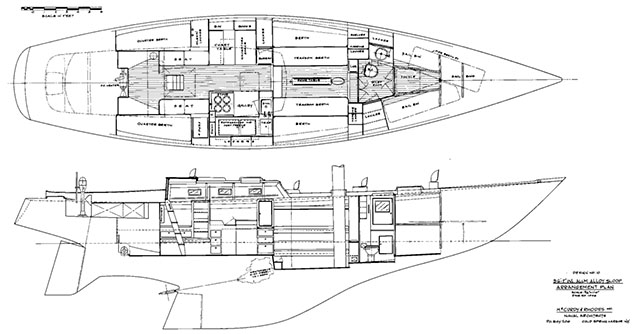 Jim McCurdy’s plans for Carina in 1968 showed a conservative interpretation of the fin-and-skeg form, and relied on a trim tab on the aft end of the fin keel to give added lift to windward.
Jim McCurdy’s plans for Carina in 1968 showed a conservative interpretation of the fin-and-skeg form, and relied on a trim tab on the aft end of the fin keel to give added lift to windward.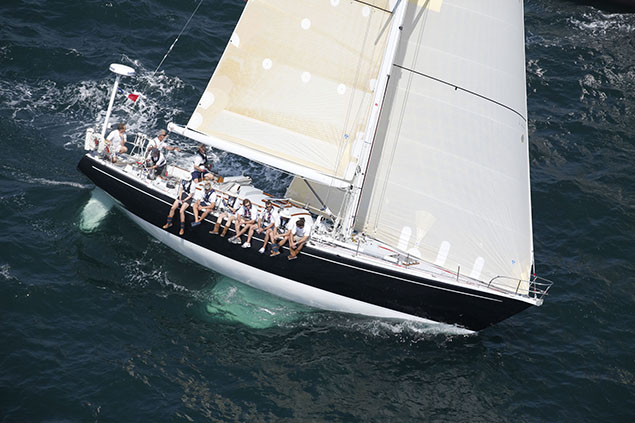 Carina as she is today, and still winning races. She has a spade rudder and Peterson/Holland fin keel arrangement designed by Scott Kaufmann.
Carina as she is today, and still winning races. She has a spade rudder and Peterson/Holland fin keel arrangement designed by Scott Kaufmann.
But that trim tab was punished by changes to the rating rules in the early 1970s. So by 1978 they’d gone to New Zealand-born, New York-based Scott Kaufmann, and he came up with a real dream of a re-configuration with a very positive spade rudder with perfect end-plate effect on the underside of the counter, and a fin keel of the type favoured by Doug Peterson and Ron Holland.
Thanks to Carina’s alloy construction, it was a very manageable job, even if those actually doing it in Bob Derecktor’s famous boatyard found the initial aluminium grinding and cutting to be dusty hard labour. One of that work team was Rives Potts, who has now owned Carina himself for many years, and she continues to win races.
As for her seaworthiness under her new keel and rudder, that was immediately proven beyond all doubt with her successful participation in the 1979 Fastnet. But not all rudder conversions have been so successful. The lovely Firebrand ended up in America, and some owner decided she needed a fin and skeg rudder arrangement. The job was done, but then when she was sold back to Europe, the new skeg broke clean off while sailing Transatlantic. But thankfully it was an add-on rather than an insert into the basic construction, so she got across in one piece.
And then her luck turned. She was spotted by international yacht designer Ed Dubois, who fell in love with her, and decided to make Firebrand his pet boat. Her personally designed a special spade rudder which would retain the classic character of the yacht while improving the steering, and under this arrangement, between intervals of designing superyachts for other people, he had many cherished times sailing and cruising this most beautiful vanished boat before his untimely death at the age of 63 earlier this year.
It’s a great compliment to the beauty of the hull designs of Olin Stephens that a designer of Ed Dubois’s standing should not only choose one of his boats, but at the Dubois home it was a fine photo of Firebrand under sail which had pride of place above the living room fire.
So boats can go through good times as well as bad, and one much worked-on boat which is currently sitting pretty is Anthony Bell’s hundred foot Perpetual LOYAL, line honours winner in the Rolex Sydney-Hobart race, and second overall on corrected time. In that kind of company, it is an achievement comparable with Rambler 88’s performance in the Volvo Round Ireland Race back in June. Yet in all the excitement, how many now remember that back in August 2011, Perpetual LOYAL was Rambler 100, and she was very upside-down with a broken keel out at the Fastnet Rock?
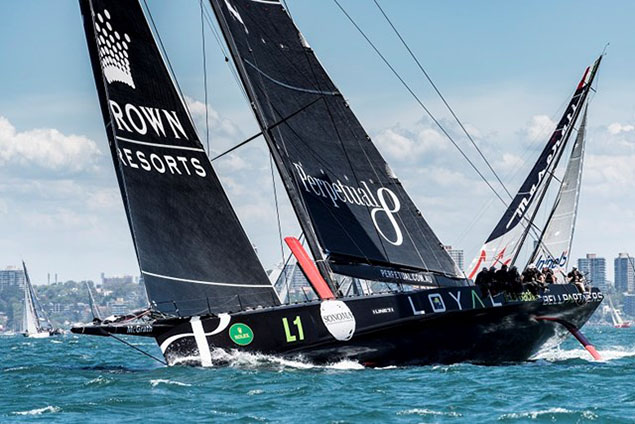 Perpetual LOYAL leads the fleet out of Sydney Harbour five days ago in the Rolex Sydney Hobart Race 2016. Photo Rolex
Perpetual LOYAL leads the fleet out of Sydney Harbour five days ago in the Rolex Sydney Hobart Race 2016. Photo Rolex
 Once upon a time, near the Fastnet Rock..…..Perpetual LOYAL as she was as Rambler 100 in August 2011
Once upon a time, near the Fastnet Rock..…..Perpetual LOYAL as she was as Rambler 100 in August 2011
Delay In transfer of Dun Laoghaire Harbour Company to Council ‘Not Satisfactory’ - Ross
#PortTransfer - Minister for Transport Shane Ross has said the transfer of the Dún Laoghaire Harbour Company to local authority control is taking too long, writes The Irish Times.
“Dún Laoghaire is certainly the slowest of these ports that will be taken into local authority control,’’ Mr Ross said.
“I accept the delay in decision-making and progress in any direction is not satisfactory.’’
The company, which is the State enterprise responsible for the maintenance and development of the harbour, is to be transferred to the control of Dún Laoghaire-Rathdown County Council under the Harbours Act 2015.
Mr Ross said the council had commissioned consultants to conduct the “due diligence’’ of the company and had recently forwarded a draft report for the company’s consideration.
He said he also understood both sides had established transitional teams to work on the practical issues associated with the transfer.
Mr Ross was responding to a strongly-worded attack on the company in the Dáil by Dún Laoghaire AAA-PBP TD Richard Boyd Barrrett.
For more on the port transfer story, click here
Delayed Ship 'Returns' To Dublin Bay For Christmas
#TankerDublinBay - Lorna Siggins of the Irish Times writes that seafarers are used to spending Christmas at sea, but one ship’s complement in Irish waters will have a more unusual experience than most.
Some 13 crew on board the 129-metre tanker Iver Ability as previously reported on Afloat, will be neither out of sight nor out of mind in Dublin Bay due to “issues” with unloading the ship’s cargo.
The red- and white-hulled vessel has already spent more than four months on the anchorage, apart from several brief forays into Dublin Port for supplies.
Illuminated at night, it has become a talking point for coastal walkers.
Managers of the Gibraltar-registered ship have confirmed that it was transferred on to the anchorage in August after it “experienced a reaction to its cargo of bitumen during cargo operations in the port”.
It is understood that a seal on its hatch ruptured while on berth in Dublin Port, and posed a potential safety hazard.
The ship’s owners say that the situation has “stabilised”, with “no further pressure release of the cargo occurring”, and that they have been conducting a “full investigation”.
For more click here noting that further in the report, it was mentioned Iver Ability was in Dublin Port this week to take on supplies and also during Storm Barbara to await subsiding winds.
Afloat.ie can confirm as of this morning the tanker has departed from the Deepwater Quay with assistance of tug Beaufort, before heading under way for yet another anchorage and notably to be spent over Christmas.
Minister Launches Dun Laoghaire Harbour Bicentenary Steering Group
#Bicentenary - Minister for Jobs & Innovation Mary Mitchell O'Connor today became Patron of the Dun Laoghaire Harbour Bicentenary programme.
Convening in the historic Harbour Lodge in Dun Laoghaire, the Minister met members of the Steering Group, which includes the Pavilion Theatre, DLR County Council, the RNLI, the Coal Harbour Users Group, The National Maritime Museum, Dalkey Heritage Centre, a representative of the 4 Yacht Clubs, the Dun Laoghaire Harbour Company and Dun Laoghaire Business Improvement District (BID).
The Bicentenary Steering Group met to discuss a series of initiatives to commemorate and celebrate the 200 year history of this historic harbour.
May 31st 1817 saw the laying of the first stone in the creation of one of the world’s finest man-made harbours, originally named as "The Royal Harbour of King George IV at Kingstown"
Gerry Dunne, CEO of Dun Laoghaire Harbour Company said " this is an incredibly exciting initiative , of national and international significance. We will be engaging with members of the Irish Diaspora all over the world, so that we can gather relevant stories and memorabilia, and create a legacy both online and physical, a legacy which this special place fully deserves"
Defence Forces International Operational Service Medal Ceremony to take Place in Dun Laoghaire
#ServiceMedal - International Operational Service Medals are to be presented to members of the Permanent Defense Force at a ceremony held in Dun Laoghaire Harbour.
The ceremony on Carlisle Pier (12 noon Saturday, 26 November) is in recognition of their humanitarian mission overseas. To mark the occasion the Naval Service OPV LE James Joyce (P62) will be berthed alongside.
The event will not be open the public but can be viewed from the Harbour Plaza next to the former ferry terminal or the East Pier.
LE James Joyce is the fifth Naval Service vessel to have been deployed since the Irish State joined the Mediterranean mission in May last year. By early September, sixteen bodies were recovered by the 59-strong crew and a total of 1,882 migrants including 56 children were rescued.
Last year the €50m OPV90 class newbuild was docked at Carlisle Pier having been named by Ms Carol Joyce who is a grand-niece of James Joyce.
Cruise Berth at Dun Laoghaire Gets Go Ahead, But It's Not All Plain Sailing for Locals
#CruiseBerth - Mixed reaction from local businesses follows the decision to grant a new cruise ship berth with planning permission in Dun Laoghaire Harbour, writes the Herald.ie
The €18m development will allow ships of 250 metres in length to enter the port, paving the way for luxury cruise liners to dock at Dun Laoghaire. But locals are concerned that they will see little of the increased tourist trade promised by the development.
"It's going to put more nails in the coffin in Dun Laoghaire," said Andrew Ball, of Dunphy's Bar. "I personally don't think it's going to give us anything. People get on buses and go to the city - we don't see much of the benefit."
Neglected
Danielle Kelly, of Hicks butchers, said that anywhere away from the seafront has been "forgotten about".
"It was better when the boats from England were coming over on day trips. Most were originally from Dun Laoghaire or local and would stay here for the day," she said. "But now because they've stopped them they're all going out to town."
Declan Coates of Cameo Jewellers said that money might be better spent on developing the town. "It's lovely down on the seafront, but they've neglected up here on the streets," he said.
However, some locals were looking forward to added business from the cruise ships.
For more responses to the planning decision, the newspaper has more here.


























